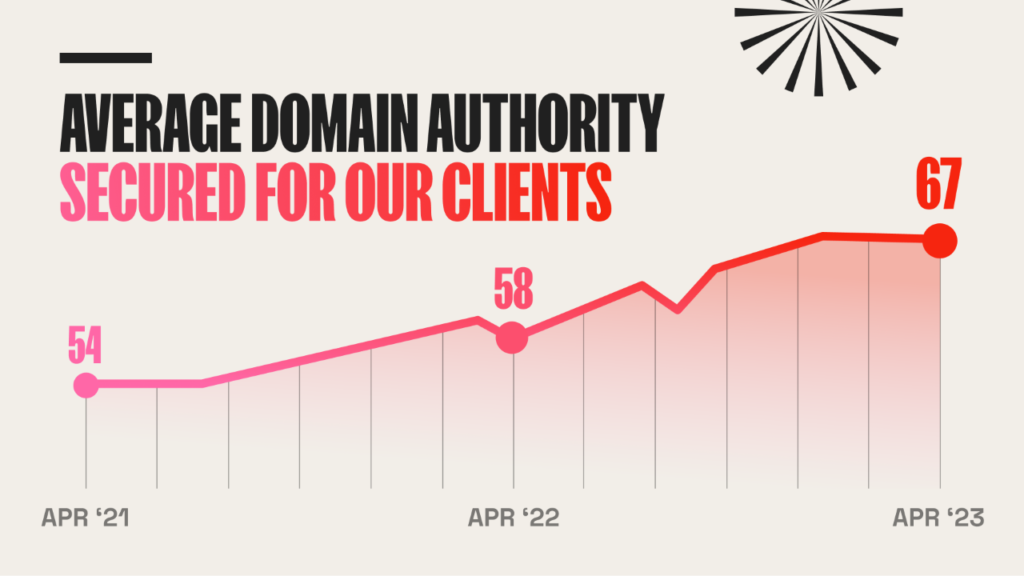Average Domain Authority On Coverage Secured For Clients Is On the Up!
By Head of SEO, Marten Lazarus
We are proud to announce that 72Point's average domain authority - for the coverage output we achieve - continues to rise. Throughout April we hit a new high of an average of 67 across our coverage tally.
Adding to our average tally of 46 articles secured per campaign, that DA average is up 15% this year alone.
This is an important metric that points to a commitment to securing quality coverage, that helps move the dial on our client's objectives. In recent years, we have put a considerable amount of focus on taking the quality of our coverage to the next level, so we are delighted with this marked improvement.
Domain Authority (DA) is a search engine ranking score developed by Moz that predicts how likely a website is to rank in search engine result pages (SERPs). Domain Authority scores range from one to 100, with higher scores corresponding to greater likelihood of ranking.
Domain Authority is based on data from Moz's Link Explorer web index and uses dozens of factors in its calculations. The actual Domain Authority calculation itself uses a machine learning model to predictively find a "best fit" algorithm that most closely correlates link data with rankings across thousands of actual search results that they use as standards to scale against.

72Point acquires picture and video agency PinPep
PinPep Media Limited has been acquired by the SWNS Media Group, bringing it together with consumer agency 72Point and its other brands.
PinPep founders James Pinniger (Managing Director) and Joe Pepler (Creative Director) join the 72Point Board, and will assume the roles of Head of Visual and Creative Director respectively. The PinPep brand will remain, and not be consumed into 72Point.
Chris Pharo, 72Point’s Managing Director said: ”I have long admired PinPep’s work and as we build out our range of creative services, joining forces with James and Joe, with their vast knowledge of the power of pictures and video in bringing PR campaigns to life, was a no brainer.”
“We have made great strides in video production in the past few years and James and Joe’s experience will add a new dimension to the work so ably conducted by our Broadcast Director Dan Harding.”
“72Point is regularly commissioned to handle words, video and distribution only to find Joe, or another great PinPep photographer on the same assignment. Now we are one team and I’m really excited to see what the future holds.”
James Pinniger said: ”As soon as we started talking to Chris and his team at 72Point it was clear that they shared our vision and understood the importance of working closely with brands to create high-quality visual content for successful PR campaigns. ”
“We’ve always had ambitious plans for PinPep, and it quickly became clear that joining with 72Point would allow us to accelerate the growth of the business and tackle even more exciting projects. We are relishing the opportunity to work as part of this highly creative team, and can’t wait to get cracking.”
Joe Pepler said:” When we were approached by 72Point, it became very clear right from the start that we were a perfect fit for each other. As a combined force we will be able to offer the complete package to clients at the highest of standards. There simply isn’t any other company that can match that. I’m incredibly excited to get going with the new resources at our disposal...let’s see where it can take us!”
72Point ranked number 37 in PR Week’s Top 150 agencies (and no.8 in the Consumer PR rankings) with a fee income in excess of £10m.
PinPep launched in 2017 and has worked with brands including Asda, Disney, Lego and Virgin Atlantic.
Read more from PRWeek.
Google’s Spambrain: Why Quality Link Building Is More Important Than Ever
Marten Lazarus, Head of SEO
You might remember Google’s announcement back in December 2022, an update to its ever-evolving link spam efforts called “Spambrain”, Google's spam-detection algorithm, designed to find and remove low-quality websites from the search results.
When I fell into SEO over 16 years ago, the techniques we were using to improve our clients’ websites would not even be considered today as it would be both a waste of time and incredibly risky for all parties involved! Google has come a long way in developing its systems and algorithms to, in my mind, try to replace as much of the human review required when determining what is constituted as “spam”.
If you look at what is considered spam today from old backlinks, it is obvious that these pages are not built for humans to read, but purely for links. I still occasionally see examples of this, but nowadays it is far more carefully done. If you look at a bunch of the links pointing to your site and think “I would never read this page” then you might be sitting on a timebomb waiting for Google to bring the match to light the fuse.
As someone who worked in SEO before the Panda (low quality content penalty) and Penguin(low quality backlinks) updates, and can even remember the Caffeine update in 2010, it has (at least in my mind) always been a balancing act when it comes to link building. Something that might provide quick results and shoot your rankings up on Google does often sound very appealing. As the classic saying goes “if it sounds too good to be true”... and you know the rest!
Those that have more of a medium to long term view will already have realised that along with traditional marketing practices, SEO is an ever-evolving practice in which one builds an amazing website upon a strong set of technical principles and foundations.
For PR and SEO, it’s the best ideas executed in the best ways that bring top-class results – something that is true for both disciplines. It is also true that you remember a failed campaign, rather than the great early work that went into it.
When I train or educate people on SEO, it starts with how you think about your business, clients, and current and potential customers. I then branch out into understanding what search engines are built to achieve – the highest possible quality of results based on what the searcher wants. We must first broadly understand the criteria that search engines are using to best match these searches before we can then understand how to adjust things on our websites.
With increasing developments in AI and machine learning, it is a matter of when, not if search engines will be fullyrun by machines. A scary thought? – perhaps this article you’re reading was entirely written by one.
CREATIVE HITS & MISSES - Dan Harding & PRWeek
Daniel Harding, broadcast editor at 72Point, analyses this week’s creative offerings for PRWeek, read the article here.
Katie Earlam - Creative Q&A with PRWeek
Katie Earlam, 72Point's Campaigns Director spoke to PRWeek on how she got to where she is, her career highlights, and many more. Read the full article here.
Our Diary Is Filling Up...
There has been a notable increase in our clients requesting news generation support in recent weeks, cementing the importance of brands staying at the front of consumers mind now more so than ever. Clever content has always played an important role in marketing strategies, but in times of uncertainty, we place ever increasing value in the publications we trust.
People have more time on their hands and are constantly checking in with their favoured publications for engaging content that provides some light relief. Publishers are also actively seeking stories that engage, and there is plenty of appetite for PR activation.
That’s where we come in.
Our calendar is filling up, and the response we've been getting shows that demand is strong. Unique opportunities present themselves daily for brands to reach their consumers in powerful and meaningful ways.
We landed 2,590 pieces of coverage over 45 projects in March alone, and that count has already increased to 55 projects for April. We are specialists in landing stories on their desired platforms and liaising with clients on the expert messaging these stories contain.
Contact us now to talk about your news generation project, support on distributions/sell-in and widespread media coverage.
Influencer Marketing: What's It All About?

Celebrity endorsements have always been used to create excitement around a brand. But the prevalence of social media has welcomed a world of bloggers, content creators and influencers. Brands are noticing this, and now these people are taking over our timelines with #ads and are, in their own way, a whole new type of celebrity.
Influencer marketing involves businesses collaborating with popular, relevant influencers and micro-influencers within their niche to propel their brand’s message. By forming a partnership, the influencer will agree to share the brand through a strategy of reviews, social posts, promotional discount codes, and gifted products, usually on their social media channels.
Unlike celebrity endorsements, influencer marketing does more than just attach the face of a celebrity to a product. Although the strategies tend to overlap, a distinguishing factor separating celebrity endorsements and influencer marketing is that influencers are often real-life consumers themselves, with their passion for certain topics empowering them to influence the decisions of their followers. For example, the perfectly-sculpted fitness blogger who regularly posts their training regime is likely to be asked to advertise for a sportswear brand. The influencer’s followers will trust their recommendation and will probably use their unique promotional code to get discount when they buy the advertised product.
To keep in-line with the brand’s message and build an audience of trusting consumers, it is important to work with a suitable influencer - it wouldn’t make much sense for a food blogger to promote a new make-up product.
Think about Justin Bieber and the #MyCalvins campaign (sorry to bring my celebrity crush into this). Bieber isn’t an underwear expert and doesn’t need to be an underwear expert to recommend Calvin Klein, his fame is enough to drive an interest in the product.
Influencers, however, will often have an area that they specialise in, meaning their followers and themselves share a common interest, so when they endorse or recommend a product their followers are likely to take interest. To keep in-line with the brand’s message and build an audience of trusting consumers, it is important to work with a suitable influencer - it wouldn’t make much sense for a food blogger to promote a new make-up product if they want to appear authentic.
These social media celebs, who could range from a following from just a few thousand, up to several million, are highly regarded by their followers and share a strong rapport and relationship with them. By leveraging the voice of an influencer, a brand can build trust with their target audience by using the influencer to become part of an ongoing conversation across their social channels. With many influencers being bloggers, Youtubers, and models, this means a brand can constantly be provided with new posts, videos, edits and engaging and creative visuals. Influencers are constantly active, and constantly promoting themselves and the brands they partner with, and that’s the great power of social media – it is always ‘on’.
Brands should be using influencer marketing; it has proven to be a positive strategy to create noise and stand out among other businesses online. It is important in this world to have a presence on social media to not get left behind. These influencers can help to build large and engaged followings by driving traffic to social accounts, resulting in more potential consumers. We shouldn’t overlook the power of the Insta-famous!
Just Give Me The Recipe
By Jack Peat

Why is it so darn hard to find a recipe without the incessant guff these days?
Earlier this month Kathryn Watson, a reporter for CBS News, posted a concern that will have likely irked anyone who has ever used Google to search for the perfect meal.
“I hate recipes on the Internet”, she said. “I do not care about your cute little story and pictures. Just tell me the ingredients and how I’m supposed to turn them into deliciousness.”
We feel her pain, right?
Ever since foodie bloggers and gastro mags exploded on the internet we have been bombarded with alluring meal ideas which require you to navigate a barrage of nonsensical info before you get to anything remotely useful.
As actor Mickey White said in response to Watson’s grumble, “my favourite link on all Foodie blogs is “Jump To The Recipe””, which is surely one of the most utilised shortcuts on the internet right now.
Content-heavy approach
But the bloggers are not to blame for the infuriating scroll-frenzy that has become the scourge of most recipe searches; Google is.
A simple look through the recommended properties on its developer page will tell you all you need to know.
Some 20 elements should be incorporated in any recipe page to make it rank highly in search, many of which require a fully fleshed-out piece of writing to incorporate, which is why most foodie sites are adopting a content-heavy approach.
Structured data for rich results
It’s something that is worth bearing in mind for any site that could benefit from structured data as a means of enhancing its search visibility.
Structured data is increasingly being used by Google to display rich results and better understand the web page itself.
It’s the reason recipe results display with a rating, calorie count, cooking time and a text snippet in search, and you can build that out across several disciplines if you adhere to Google’s guidelines.
SEO experts
Here at 72Point, we are experts at creating SEO-optimised packages to enhance your search rankings using the power of the press.
Check out some of our useful resources below to find out how:
The Perfect PR Package For SEO
In An Age Where SEO Is King, This Project Ruled
Looking To Secure A Follow Link In Press Coverage? Follow Our Traffic Light System
Why Do So Many PRs Look The Same?
By Geo Craig
Mixed-race, 21 year old, former aspiring footballer who left the education system aged 16 and with no A-levels or uni degree to his name. Not exactly the archetypal platform from which to launch a PR career at a top consumer agency - but why is this the case? In an industry where our job is to get under the skin of brands and what makes their customers tick, why do so many PRs look, dress, speak and think in the exact same way? Surely that can only breed ideas that speak to a certain market of individuals, and if fame, vast exposure and virality is the benchmark here then there should be as much cultural representation in every brainstorm as possible.
I’m not going to lie and say it’s easy working in an industry where so few at board level, or even senior positions, look and speak like me. It’s immediately noticeable whenever something remotely ‘urban’ comes up in storm, and heads turn towards me. This will be a familiar feeling for any creative who looks even partially ethnic. Why do we have to be the sole torch bearers of inclusion, why can’t there just be a general attitude shift across the board? It’s time now for a recruitment strategy that actively seeks out those with unorthodox backgrounds, recognising the possibilities having a truly diverse team would open up.
The truth is, brands have arguably the biggest part to play in the issue of diversity, as they have the audience and platform to send out the right messages. They need to start understanding that just installing Common as a face of a campaign, or, worse still, getting Kendall Jener to open a can of Pepsi, does not constitute a ‘diversity campaign’. It just feels like an after-thought and is clearly the brainchild of a meeting that contained not one person who represented the audience they were trying to reach. It’s just simply not real enough, and if anything, it deters BAME candidates from a career in advertising and PR - why would they want to take part in an industry that more often than not, clumsily botches it’s job of engaging with them?
So, more diversity in teams will naturally result in a more wide-reaching and considered suite of ideas. Great. But what benefit does having an ‘unconventional’ mentality have on personal working experiences?
My own unorthodox PR background has, in fact, been my biggest strength early on in my career. It has allowed me to see industry with a fresh mind, chat to various experts around me and quickly pick-up skills. Diversity fosters an environment of constant learning, where no 2 team-members experience is the same, and where creativity is constantly tried and tested amongst a wider sample group of society. If you can constantly challenge your team to learn on-the-job, not only about industry, but also different cultures, then surely as an employer, you are fulfilling your duty to provide staff with the opportunity to grow. [/vc_column_text][/vc_column][/vc_row]
Been there…done that…bear the scars
By Chris White-Smith

Personal record - Played 3 – Won 1, Lost 2
So mid-table mediocrity in the league of successful funding. On what basis, therefore, my right to posit about the tactics for success? Simple - Failure.
The most successful entrepreneurs fail brilliantly. Perceived wisdom suggests that if you’re not failing, you’re too cautious and caution is the first turn off for investors. On that basis, I’m in….
One chance with a potential investor, probably one minute, 5 at the most, so you’d better be prepared – prepare to blow’em away, and prepare for plenty of no’s, not because your idea isn’t great, more the ratio of opportunity to investment most make. I put your chances on average at best 1:100, so don’t fear failure. Its nothing personal.
Channel that fear to adrenalin and passion. But watch out for dilusion, a fast track to fanciful planning. Fact - Investors won’t believe your plan, however ‘genuinely realistic’ you believe. They’ll slash it, and give it the once over. If it passes first muster, they’ll halve it again. If it passes again, you’re chances just increased by a smidge.
All adds up to a massive adrenalin rush. So if you ain’t got that hit, you shouldn’t be in the room.
9 out of 10 start ups don’t make it, for a million different reasons - Investors know that too. The passion for success must be shared, so invest in your investor for value-add beyond cash - its a rollercoaster ride, and you’ve got to feel them feel it.
So my top 10 tips for maximizing your chances: (by-passing the ‘Have a great idea’ bit):
1. Prepare for no’s
2. Invest in your investor
3. Be tight with your equity
4. Borrow small. Crowdfund as last resort
5. Blow away pitch – 5 mins max to hook them
6. Prove the market in the gap – No blag…they’ll find it
7. Believe at every stage
8. Be confident and passionate, not arrogant
9. Be clear on the exit
10. Be Lucky
I was lucky once. I’ll take that…
Good Luck!




